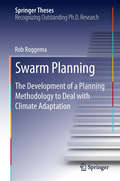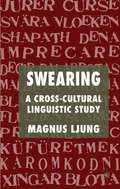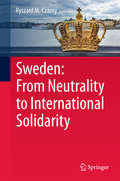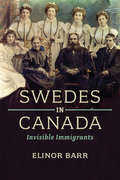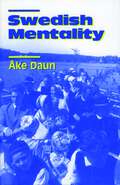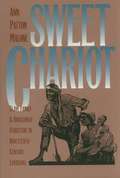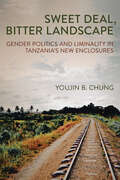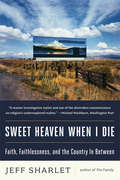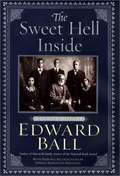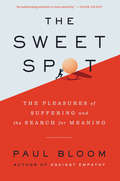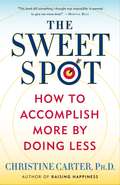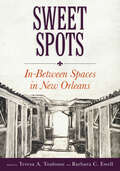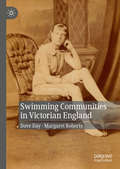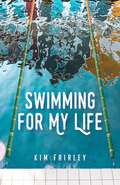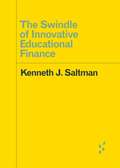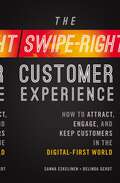- Table View
- List View
Svalbard Imaginaries: The Making of an Arctic Archipelago (Arctic Encounters)
by Mathias Albert Dina Brode-Roger Lisbeth IversenBy drawing on a broad range of disciplinary backgrounds, this book illustrates the immense complexities of Svalbard as a place, point of reference, or social concept. It portrays the multiple, situated perspectives that characterize understandings and imaginings of Svalbard, and brings together contributions from academic fields that rarely interact with each other.Svalbard Imaginaries contributes to a number of research contexts, ranging from a broadly conceived, multi-disciplinary field of ‘Arctic Studies’ to more disciplinary specific debates on how places are reworked at the interstices of various global flows and vice versa. It assembles contributions on imaginaries that cover a wide array of issues, including—but not limited to—Svalbard as a geopolitical site, a landscape, an image, a (mining) heritage assemblage, a tourist destination, a wilderness, a built environment, a site of knowledge production, a site of artistic engagement, and projections of the future. It deliberately assembles analyses that refer to a variety of timescales and covers representations of the past, the present, and possible futures of Svalbard.
Swarm Planning
by Rob RoggemaThis book shows that the problem of climate adaptation, which is described in social planning terms as 'wicked,' is at odds with the contemporary practice of spatial planning. The author proposes a new adjusted framework which is more adaptable to unpredictable, wicked, dynamic and non-linear processes. The inspiration for this new method is the behaviour of swarms: bees, ants, birds and fish are capable of self-organization, which enables the system to become less vulnerable to sudden environmental changes. The framework proposed in Swarm Planning consists of these four elements: Two levels of complexity, the first being the whole system and the second its individual components. Each of these has different attributes for adapting to change. Five layers, consisting of networks, focal points, unplanned space, natural resources and emerging occupation patterns. Each layer has its own spatial dynamic, and each is connected to a spatial scale. Non-linear processes, which emerge in different parts of the framework and include emerging patterns, connectedness and tipping points among others. Two planning processes; the first, 'from small to large' works upward from the slowest changing elements to more rapidly-changing ones. The second, 'on the list of partners' addresses each layer from networks through emerging occupation patterns. Swarm Planning applies this framework to a series of pilot studies, and appraises its performance using criteria for an adaptive landscape. The results show that the use of the Swarm Planning Framework reduces the vulnerability of landscapes as well as the impact of climate hazards and disasters, improves response to unexpected hazards and contains adaptation strategies. "This book is a must for planners in government and the private sector as it outlines the concept, strategies and techniques for swarm planning. It is also an important guide for policymakers looking to engage communities in a dialogue about the adaptation planning process. " Professor John Martin, La Trobe University "The ultimate value of the book lies in encouraging the planning community to consider options that go far beyond those offered by business-as-usual planning methodologies developed for a set of operating conditions that are fast becoming obsolete. As such it makes an important and much needed contribution to the field. " Assistant Professor Dr. Chrisna du Plessis, University of Pretoria
Swearing
by Magnus LjungThis study provides a definition and a typology of swearing and compares its manifestations in English and 24 other languages. In addition the study traces the history of swearing from its first known appearance in Ancient Egypt to the present day.
Sweatshop Strife: Class, Ethnicity, and Gender in the Jewish Labour Movement of Toronto, 1900-1939
by Ruth FragerIn the first half of the twentieth century, many of Toronto's immigrant Jews eked out a living in the needle-trade sweatshops of Spadina Avenue. In response to their expliotation on the shop floor, immigrant Jewish garment workers built one of the most advanced sections of the Canadian and American labour movements. Much more than a collective bargaining agency, Toronto's Jewish labour movement had a distinctly socialist orientation and grew out of a vibrant Jewish working-class culture.Ruth Frager examines the development of this unique movement, its sources of strength, and its limitations, focusing particularly on the complex interplay of class, ethnic, and gender interests and identities in the history of the movement. She examines the relationships between Jewish workers and Jewish manufacturers as well as relations between Jewish and non-Jewish workers and male and female workers in the city's clothing industry.In its prime, Toronto's Jewish labour movement struggled not only to improve hard sweatshop condistions but also to bring about a fundamental socialist transformation. It was an uphill battle. Drastic economic downturns, hard employer offensives, and state repressions all worked against unionists' workplace demands. Ethnic, gender, and ideological divisions weakened the movement and were manipulated by employers and their allies.Drawing on her knowledge of Yiddish, Frager has been able to gain access to original records that shed new light on an important chapter in Canadian ethnic, labour, and women's history.
Sweden: From Neutrality to International Solidarity
by Ryszard M. CzarnyThis book presents the legal and political factors determining international relations, including the processes of integration in all their complexity. The overall structure of the book, together with the composition of its separate chapters, allows for some general assumptions, identifying the main tendencies and placing them in a contemporary social context as well as establishing their relations with the practices of today. The content is a compendium of basic information and data related to the international processes which occur within specific formal, legal and political frames. The book is divided into five parts featuring not only deep historical context but most of all presenting current information and analyses of the last few years. Presented against the background and within the context of the Kingdom of Sweden’s political system and its international environment, the book brings into the foreground issues of particular importance for Sweden’s continuing European integration process and describes its response to the developments in the international situation.
Sweden's Welfare State
by Subhash Thakur Michael Keen Balázs Horváth Valerie CerraThe Swedish Prime Minister, Gèran Persson, has used the analogy of a bumblebee to describe the success of the Swedish welfare state, saying "Think of a bumblebee. With its overly heavy body and little wings, supposedly it should not be able to fly, but it does. " Drawing on its continued surveillance of the economic policies of IMF member states, this book examines the Swedish model and considers both its achievements and the challenges facing it in the 21st century. It also seeks to draw lessons from the Swedish experience for other countries that face similar challenges from developments in globalisation and demographics.
Swedes in Canada
by Elinor BarrSince 1776, more than 100,000 Swedish-speaking immigrants have arrived in Canada from Sweden, Finland, Estonia, Ukraine, and the United States. Elinor Barr's Swedes in Canada is the definitive history of that immigrant experience. Active in almost every aspect of Canadian life, Swedish individuals and companies are responsible for the CN Tower, ships on the Great Lakes, and log buildings in Riding Mountain National Park. They have built railways and grain elevators all across the country, as well as churches and old folks' homes in their communities. At the national level, the introduction of cross-country skiing and the success of ParticipACTION can be attributed to Swedes.Despite this long list of accomplishments, Swedish ethnic consciousness in Canada has often been very low. Using extensive archival and demographic research, Barr explores both the impressive Swedish legacy in Canada and the reasons for their invisibility as an immigrant community.
Swedish Mentality
by Åke DaunIs there a distinctly Swedish national character? Are Swedes truly shy, unemotional, conflict-avoiding, melancholy, and dour? Swedish Mentality, the English translation of the hugely successful book published in Sweden in 1989, considers the reality behind the myth. The author, Åke Daun, is a respected ethnologist who is sometimes referred to as the "guru" of Swedish character. In recent years, it has become popular to discuss Swedishness and Swedish identity. The advent of the European Union and the increasing presence of immigrant refugees in Sweden have fueled public debate on the distinctiveness of Swedish culture. Daun, however, goes beyond stereotype, drawing upon statistics gathered over more than a decade of research. The result is an entertaining and engagingly written book. Throughout, Daun quotes from interviews with native Swedes and immigrants as well as from travel accounts, folklore, and proverbs. We learn why some Swedes might prefer to walk up a flight of stairs rather than share an elevator with a neighbor and why some gain satisfaction from walking alone in the woods or going fishing. Daun describes a range of factors influencing Swedish character, including population composition, rural background, and even climate. He recognizes behavioral variations related to gender, age, class, and region, and he considers subtleties of individual character as well.Swedish Mentality should interest a wide array of readers, whether of Swedish descent or not.
Sweet Burdens: Welfare and Communality among Russian Jews in Germany
by Sveta RobermanSweet Burdens presents a detailed ethnographic study of the lives of Russian-Jewish immigrants in Germany over the past twenty years. Focusing on the first generation of adult immigrants, Sveta Roberman examines how they question and negotiate their moral economy and civic culture vis-à-vis the host German state and society, on the one hand, and the Holocaust past, on the other. She approaches the immigrant-host encounter as one of many cycles of social exchanges taking place in multiple and diverse arenas. The book sheds light on a number of issues, including the moral economy of Jewish-German relations, immigrants' performances of civics and citizenship, modes of inclusion and exclusion, consumption and consumerism, work and the phenomena of unemployment and underemployment, the concept of community, and the dynamics and difficulties of reinventing Jewish identity and tradition.
Sweet Chariot
by Ann Patton MaloneSweet Chariot is a pathbreaking analysis of slave families and household composition in the nineteenth-century South. Ann Malone presents a carefully drawn picture of the ways in which slaves were constituted into families and households within a community and shows how and why that organization changed through the years. Her book, based on massive research, is both a statistical study over time of 155 slave communities in twenty-six Louisiana parishes and a descriptive study of three plantations: Oakland, Petite Anse, and Tiger Island.Malone first provides a regional analysis of family, household, and community organization. Then, drawing on qualitative sources, she discusses patterns in slave family household organization, identifying the most significant ones as well as those that consistantly acted as indicators of change. Malone shows that slave community organization strongly reflected where each community was in its own developmental cycle, which in turn was influenced by myriad factors, ranging from impersonal economic conditions to the arbitrary decisions of individual owners. She also projects a statistical model that can be used for comparisons with other populations. The two persistent themes that Malone uncovers are the mutability and yet the constancy of Louisiana slave household organization. She shows that the slave family and its extensions, the slave household and community, were far more diverse and adaptable than previously believed. The real strength of the slave comunity was its multiplicity of forms, its tolerance for a variety of domestic units and its adaptability. She finds, for example, that the preferred family form consisted of two parents and children but that all types of families and households were accepted as functioning and contributing members of the slave community."Louisiana slaves had a well-defined and collective vision of the structure that would serve them best and an iron determination to attain it, " Malone observes. "But along with this constancy in vision and perseverance was flexibility. Slave domestic forms in Louisiana bent like willows in the wind to keep from shattering. The suppleness of their forms prevented domestic chaos and enabled most slave communities to recover from even serious crises."
Sweet Charity?: Emergency Food and the End of Entitlement
by Janet PoppendieckIn this era of eroding commitment to government sponsored welfare programs, voluntarism and private charity have become the popular, optimistic solutions to poverty and hunger. The resurgence of charity has to be a good thing, doesn't it? No, says sociologist Janet Poppendieck, not when stopgap charitable efforts replace consistent public policy, and poverty continues to grow. In Sweet Charity?, Poppendieck travels the country to work in soup kitchens and "gleaning" centers, reporting from the frontlines of America's hunger relief programs to assess the effectiveness of these homegrown efforts. We hear from the "clients" who receive meals too small to feed their families; from the enthusiastic volunteers; and from the directors, who wonder if their "successful" programs are in some way perpetuating the problem they are struggling to solve. Hailed as the most significant book on hunger to appear in decades, Sweet Charity? shows how the drive to end poverty has taken a wrong turn with thousands of well-meaning volunteers on board.
Sweet Deal, Bitter Landscape: Gender Politics and Liminality in Tanzania's New Enclosures (Cornell Series on Land: New Perspectives on Territory, Development, and Environment)
by Youjin B. ChungSweet Deal, Bitter Landscape brings us to the mid-2000s, when the Tanzanian government struck a deal with a foreign investor to convert more than 20,000 hectares of long-settled coastal land to establish a sugarcane plantation. Ten years on, the deal was abruptly abandoned. Popularly deemed a case of hubristic global development, critics classified this project another in a line of failed modern resource grabs. Youjin B. Chung argues such tidy accounts conceal myriad and profound implications: not only how gender, history, and culture shaped the project's trajectory, but also how, even in its stalled state, the deal upended social life on the land by setting in motion incomplete processes of development and dispossession. With rich ethnographic detail and visual storytelling, Sweet Deal, Bitter Landscape traces the lived experiences of diverse rural women and men as they struggled for survival under a seemingly endless condition of liminality. In so doing, she raises critical questions about the directions and stakes of postcolonial development and nation-building in Tanzania, and the shifting meanings of identity and belonging for those on the margins of capitalist agrarian transformation.
Sweet Heaven When I Die: Faith, Faithlessness, and the Country In Between
by Jeff Sharlet"A master investigative stylist and one of the shrewdest commentators on religion's underexplored realms."--Michael Washburn, Washington Post In this gorgeous collection of essays that has drawn comparisons to the work of Joan Didion, John McPhee, and Norman Mailer, best-selling author Jeff Sharlet reports back from the far reaches of belief, whether in the clear mountain air of "Sweet Fuck All, Colorado" or in a midnight congregation of anarchists celebrating a victory over police. Like movements in a complex piece of music, Sharlet's dispatches vibrate with all the madness and beauty, the melancholy and aspirations for transcendence, of American life.
The Sweet Hell Inside: A Family History
by Edward BallWith the panoramic story of one "colored elite" family who rises from the ashes of the Civil War to create an American cultural dynasty Edward Ball offers the historical and, literary successor to his highly acclaimed Slaves in the Family, a New York Times bestseller and winner of the 1998 National Book Award.<P> The Sweet Hell Inside recounts the lives of the Harleston family of South Carolina, the progeny of a Southern gentleman and his slave who cast off their blemished roots and achieved affluence in part through a surprisingly successful funeral parlor business. Their wealth afforded the Harlestons the comfort of chauffeurs, tailored clothes, and servants whose skin was darker than theirs. It also launched the family into a generation of glory as painters, performers, and photographers in the "high yellow" society of America's colored upper class. The Harlestons' remarkable one-hundred-year journey spans the waning days of Reconstruction, the precious art world of the early 1900s, the back alleys of the Jazz Age, and the dawn of the civil rights movement.<P> Enhanced by the recollections of the family's archivist, eighty-four-year-old Edwina Harleston Whitlock -- whose bloodline the author sharesThe Sweet Hell Inside features a portrait artist whose subjects included industrialist Pierre Du Pont; a black classical composer in the Lost Generation of 1920s Paris; an orphanage founder who created a famous brass band from the ranks of his abandoned waifs, a number of whom went on to burgeoning careers in jazz; and a Harleston mistress who doubled as an abortionist.<P> With evocative and engrossing storytelling, Edward Ball introduces a cast of historical characters rarely seen before: cultured, vain, imperfect, rich, and black, a family made up of eccentrics who defied social convention yet whose advantages could not protect them from segregation's locked doors, a plague of early death, and the stigma of children born outside marriage.<P> The Sweet Hell Inside raises the curtain on a unique family drama in the pageant of American life and uncovers a fascinating lost world.
The Sweet Spot: The Pleasures of Suffering and the Search for Meaning
by Paul Bloom“This book will challenge you to rethink your vision of a good life. With sharp insights and lucid prose, Paul Bloom makes a captivating case that pain and suffering are essential to happiness. It’s an exhilarating antidote to toxic positivity.” —Adam Grant, #1 New York Times bestselling author of Think Again and host of the TED podcast WorkLifeFrom the author of Against Empathy comes a different kind of happiness book, one that shows us how suffering is an essential source of both pleasure and meaning in our livesWhy do we so often seek out physical pain and emotional turmoil? We go to movies that make us cry, or scream, or gag. We poke at sores, eat spicy foods, immerse ourselves in hot baths, run marathons. Some of us even seek out pain and humiliation in sexual role-play. Where do these seemingly perverse appetites come from?Drawing on groundbreaking findings from psychology and brain science, The Sweet Spot shows how the right kind of suffering sets the stage for enhanced pleasure. Pain can distract us from our anxieties and help us transcend the self. Choosing to suffer can serve social goals; it can display how tough we are or, conversely, can function as a cry for help. Feelings of fear and sadness are part of the pleasure of immersing ourselves in play and fantasy and can provide certain moral satisfactions. And effort, struggle, and difficulty can, in the right contexts, lead to the joys of mastery and flow.But suffering plays a deeper role as well. We are not natural hedonists—a good life involves more than pleasure. People seek lives of meaning and significance; we aspire to rich relationships and satisfying pursuits, and this requires some amount of struggle, anxiety, and loss. Brilliantly argued, witty, and humane, Paul Bloom shows how a life without chosen suffering would be empty—and worse than that, boring.
The Sweet Spot
by Christine CarterLearn how to achieve more by doing less! Live in that zone you've glimpsed but can't seem to hold on to--the sweet spot where you have the greatest strength, but also the greatest ease. Not long ago, Christine Carter, a happiness expert at UC Berkeley's Greater Good Science Center and a speaker, writer, and mother, found herself exasperated by the busyness of modern life: too many conflicting obligations and not enough time, energy, or patience to get everything done. She tried all the standard techniques--prioritizing, multitasking, delegating, even napping--but none really worked. Determined to create a less stressful life for herself--without giving up her hard-won career success or happiness at home--she road-tested every research-based tactic that promised to bring more ease into her life. Drawing on her vast knowledge of the latest research related to happiness, productivity, and elite performance, she followed every strategy that promised to give her more energy--or that could make her more efficient, creative, or intelligent. Her trials and errors are our reward. In The Sweet Spot, Carter shares the combination of practices that transformed her life from overwhelmed and exhausting to joyful, relaxed, and productive. From instituting daily micro-habits that save time to bigger picture shifts that convert stress into productive and creative energy, The Sweet Spot shows us how to * say "no" strategically and when to say "yes" with abandon * make decisions about routine things once to free our minds to focus on higher priorities * stop multitasking and gain efficiency * "take recess" in sync with the brain's need for rest * use technology in ways that bolster, instead of sap, energy * increase your ratio of positive to negative emotions Complete with practical "easiest thing" tips for instant relief as well as stories from Carter's own experience of putting The Sweet Spot into action, this timely and inspiring book will inoculate you against "The Overwhelm," letting you in on the possibilities for joy and freedom that come when you stop trying to do everything right--and start doing the right things. Advance praise for The Sweet Spot "Illuminates the simple and sustainable path toward a precious and happy balance."--Deepak Chopra "A gift, like a good friend drawing a personal road map out of the crazy busy swirl of our overloaded lives."--Brigid Schulte, author of Overwhelmed "This book did something I thought was impossible: It seemed to give me more time."--Martha Beck, author of Finding Your Way in a Wild New World "A page-turning thriller full of proven ways to have the life you want."--Rick Hanson, Ph.D., author of Hardwiring Happiness "Timely, lively, and vital, The Sweet Spot is an immediately useful must-read."--Shawn Achor, author of The Happiness Advantage"The Sweet Spot inspired me to make immediate changes that have increased my productivity and lowered my stress."--Dan Mulhern, president, Granholm Mulhern Associates "A must-read for every overworked executive, overwrought parent, or overscheduled human being."--Jennifer Granholm, governor of Michigan, 2003-11From the Hardcover edition.
Sweet Spots: In-Between Spaces in New Orleans
by Teresa A. Toulouse and Barbara C. EwellContributions by Carrie Bernhard, Scott Bernhard, Marilyn R. Brown, Richard Campanella, John P. Clark, Joel Dinerstein, Pableaux Johnson, John P. Klingman, Angel Adams Parham, Bruce Boyd Raeburn, Ruth Salvaggio, Christopher Schaberg, Teresa A. Toulouse, and Beth WillingerMuch has been written about New Orleans's distinctive architecture and urban fabric, as well as the city's art, literature, and music. There is, however, little discussion connecting these features. Sweet Spots--a title drawn from jazz musicians' name for the space "in-between" performers and dancers where music best resonates--provides multiple connections between the city's spaces, its complex culture, and its future.Drawing on the late Tulane architect Malcolm Heard's ideas about "interstitial" spaces, this collection examines how a variety of literal and represented "in-between" spaces in New Orleans have addressed race, class, gender, community, and environment. As scholars of architecture, art, African American studies, English, history, jazz, philosophy, and sociology, the authors incorporate materials from architectural history and practice, literary texts, paintings, drawings, music, dance, and even statistical analyses. Interstitial space refers not only to functional elements inside and outside of many New Orleans houses--high ceilings, hidden staircases, galleries, and courtyards--but also to compelling spatial relations between the city's houses, streets, and neighborhoods.Rich with visual materials, Sweet Spots reveals the ways that diverse New Orleans spaces take on meanings and accrete stories that promote certain consequences both for those who live in them and for those who read such stories. The volume evokes, preserves, criticizes, and amends understanding of a powerful and often-missed feature of New Orleans's elusive reality.
Sweetness and Power: The Place of Sugar in Modern History
by Sidney W. MintzA fascinating persuasive history of how sugar has shaped the world, from European colonies to our modern dietsIn this eye-opening study, Sidney Mintz shows how Europeans and Americans transformed sugar from a rare foreign luxury to a commonplace necessity of modern life, and how it changed the history of capitalism and industry. He discusses the production and consumption of sugar, and reveals how closely interwoven are sugar's origins as a "slave" crop grown in Europe's tropical colonies with is use first as an extravagant luxury for the aristocracy, then as a staple of the diet of the new industrial proletariat. Finally, he considers how sugar has altered work patterns, eating habits, and our diet in modern times."Like sugar, Mintz is persuasive, and his detailed history is a real treat." -San Francisco Chronicle
Swept Up Lives?: Re-envisioning the Homeless City (Rgs-ibg Book Ser. #98)
by Paul Cloke Jon May Sarah JohnsenUtilizing innovative ethnographic research, Swept Up Lives? challenges conventional accounts of urban homelessness to trace the complex and varied attempts to care for homeless people Presents innovative ethnographic research which suggests an important shift in perspective in the analysis and understanding of urban homelessness Emphasizes the ethical and emotional geographies of care embodied and performed within homeless services spaces Suggests that different homelessness ‘scenes’ develop in different places due to varied historical, political, and cultural responses to the problems faced
Swimming Communities in Victorian England
by Dave Day Margaret RobertsThis book explores how different constituencies influenced the development of nineteenth-century swimming in England, and highlights the central role played by swimming professors. These professionals were influential in inspiring participation in swimming, particularly among women, well before the amateur community created the Amateur Swimming Association, and this volume outlines some key life-courses to illustrate their working practices. Female exhibitors were important to professors and chapter three discusses these natationists and their impact on women’s swimming. Subsequent chapters address the employment opportunities afforded by new swimming baths and the amateur community that formed clubs and a national organization, which excluded swimming professors, many of whom subsequently worked successfully abroad. Dave Day and Margaret Roberts argue that the critical role played by professors in developing swimming has been forgotten, and suggest that their story is a reminder that individuals were just as important to the foundation of modern sport as the formation of amateur organizations.
Swimming for My Life: A Memoir
by Kim FairleyIn 1970s Cincinnati, Kim&’s overwhelmed, financially stressed parents dragged her and her four younger siblings into swimming—starting with a nearby motel pool—as a way to keep them occupied and out of their way. When Kim was eleven, they began leaving the kids at home with a sitter while they traveled the Midwest, where they sold imported wooden ornaments from their motorhome. But when Kim&’s six-year-old brother crashed his new Cheater Slick bike and the babysitter deserted the children, what started as an accident became a pattern: Mom and Dad leaving for weeks at a time and the kids wrestling with life&’s emergencies on their own. As Kim coped in the role of fill-in mother while dealing with the stresses of elite swimming, she struggled to shape her own life. She eventually found strength, competence and achievement through swimming—and became the second female swimmer to win a full ride to the University of Southern California, where she earned two national titles. Swimming for My Life is a peek into the dark side of elite swimming as well as a tale of family bonds, reconciling with the past, and how it is possible to emerge from life&’s toxic and lifesaving waters.
The Swindle of Innovative Educational Finance (Forerunners: Ideas First)
by Kenneth J. SaltmanHow &“innovative&” finance schemes skim public wealth while hijacking public governanceCharter school expansion. Vouchers. Scholarship tax credit programs. The Swindle of Innovative Educational Finance offers a new social theory to explain why these and other privatization policies and programs win support despite being unsupported by empirical evidence. Kenneth J. Saltman details how, under the guise of innovation, cost savings, and corporate social responsibility, new and massive neoliberal educational privatization schemes have been widely adopted in the United States. From a trillion-dollar charter school bubble to the Chan Zuckerberg Initiative to celebrities branding private schools, Saltman ultimately connects such schemes to the country&’s current crisis of truth and offers advice for resistance. Forerunners is a thought-in-process series of breakthrough digital works. Written between fresh ideas and finished books, Forerunners draws on scholarly work initiated in notable blogs, social media, conference plenaries, journal articles, and the synergy of academic exchange. This is gray literature publishing: where intense thinking, change, and speculation take place in scholarship.
The Swipe-Right Customer Experience: How to Attract, Engage, and Keep Customers in the Digital-First World
by Sanna Eskelinen Belinda GerdtThe global COVID-19 pandemic forced everybody to rethink how they operate and the role that digital plays in business and in our lives. While digital may have been top of mind for many businesses, the pandemic made it essential, not just to interact and sell products and services, but as a way to meet the critical needs of your business.More than ever, people are looking for experiences, not products. And not just any experiences—but real ones that turn transactions into engagement and materialism into experimentalism. The pandemic has changed our view of the world, shifted us away from consumerism, and made us appreciate the basic human needs of finding balance and focus. In this new era, customer experience is not just a digital experience, but a perfect combination of real life and digital interaction. It could be a meditative museum experience combining art with augmented reality, or an entertaining shopping experience at a mall with omnichannel support in a virtual fitting room.The Swipe-Right Customer Experience shows how the best companies have transformed the customer experience beyond offering a technology add-on and built or rebuilt their infrastructure, processes, talent and culture around the customer experience. You will learn:How the world has changed since the global pandemic, the role of digitization, and why customer experience means everything.The secret to how top-performing companies in five different industries have rebuilt themselves around the experience they offer to customers.The internal components of organizations that must be transformed: culture, skills, processes and workflow, brand, and measuring.The new technology trends that are driving next-level customer experience.
Switzerland: Selected Issues Paper (Imf Staff Country Reports #Country Report No. 13/129)
by International Monetary Fund. European Dept.A report from the International Monetary Fund.
Switzerland: Selected Issues (Imf Staff Country Reports #Country Report No. 13/129)
by International Monetary Fund. European Dept.A report from the International Monetary Fund.

